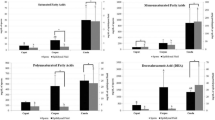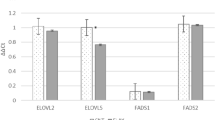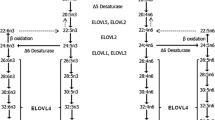Summary
Interpretation of the experimental literature on epididymal glycerophosphorylcholine metabolism according to a recently proposed de novo pathway for the synthesis of acyl-specific phosphatidylcholine suggests that epididymal glycerophosphorylcholine is an intermediate of this proposed pathway. This glycerophosphodiester is postulated to be utilized by spermatozoa to synthesize docosahexaenoic phosphatidylcholine, proposed to be required for the development of sperm motility. A defect in glycerophosphorylcholine synthesis might be responsible for some forms of asthenozoospermia.
Similar content being viewed by others
References
Diament M, Kahane E, Levy J: Sur les esters hydrosolubles de la choline. La glycerylphosphorylcholine. Comptes Rendues Acad Sci (Paris) 235:1058–1060, 1952.
Dawson RMC: The labeling of ram semen in vivo with radioactive phosphate and [carboxyj14C] stearic acid. Biochem J 68:512–519, 1958.
Dawson RMC, Rowlands IW: Glycerylphosphorylcholine in the male reproductive organs of rats and guinea pigs. Quart J Exp Physiol 44:26–34, 1959.
Young WC: Study of the function of the epididymis. III. Functional changes undergone by spermatozoa during their passage through the epididymis and vas deferens in the guinea pig. J Exp Biol 8:151–162, 1931.
Bedford JM: Maturation, transport and fate of spermatozoa in the epididymis. In Hamilton DW and Greep RO (eds). Handbook of Physiology, vol. 5. Williams & Williams, London, 1976, pp. 303–317.
Wallace JC, Wales RG, White IG: The respiration of the rabbit epididymis and its synthesis of glycerylphosphorylcholine. Austr J Biol Sci 19:849–856, 1966.
Jones R: Comparative biochemistry of the mammalian epididymal plasma. Comp Biochem Physiol 61:365–370, 1978.
Dawson RMC, Mann T, White IG: Glycerylphosphorylcholine and phosphorylcholine in semen and their relation to choline. Biochem J 65:627–634, 1957.
Sane SP, Patel KL, Pillai KBO, Shahani SM: Evaluation of glycerylphosphocholine in semen of normal and infertile men. J Reprod Fertil 66:525–527, 1982.
Williams Ashman HG, Banks J: Participation of cytidine coenzymes in the metabolism of choline by seminal plasma. J Biol Chem8:151–162, 1956.
Books DE, Hamilton DW Mallek H: Carnitine and glycerolphosphorylcholine in the reproductive tract of the male rat. J Reprod Fertil 36:141–160, 1974.
Masaki J, Tomizuka T: Seasonal variation in the content of sperm phospholipid and seminal glycerylphosphorylcholme in bull semen. Bull Nam Inst Anim Ind Jap 12:33–42, 1966.
Infante JP: Biosynthesis of acyl-specific glycerophospholipids in mammalian tissues. Postulation of new pathways. FEBS Lett 170:1–14, 1984.
Infante JP: Impaired glycerophosphorylcholine synthesis in murine muscular dystrophy. Med Biol 63:81–87 1985.
Infante JP: Defective synthesis of glycerophosphorylcholine in murine muscular dystrophy; the primary molecular lesion? FEBS Lett 186:205–210, 1985.
Scott TW, Dawson RMC, Rowlands IW: Phospholipid interrelationships in rat epididymal tissue and spermatozoa. Biochem J 87:507–512, 1963.
Hammerstedt RH, Rowan WA: Phosphatidylcholine of blood lipoproteins is the precursor of glycerophosphorylcholine found in seminal plasma. Biochim Biophys Acta 710:370–376, 1982.
Bjerve KS, Reitan LJ: The presence of an androgen controlled phospholipase A in rat epididymis. Int J Androl Suppl 2:574–591, 1978.
Poulus A, Vogelmayr K, White IG: Phospholipid changes in spermatozoa during passage through the genital tract of the bull. Biochim Biophys Acta 306:194–202, 1973.
Nissen HP, Kreysel HW: Polyunsaturated fatty acids in relation to sperm motility. Andrologia 15:264–269, 1983.
Barany M, Chang Y, Arus C, Rustan T, Frey W: Increased glycerol-3-phosphorylcholine in post-morten Alzheimer's brain. Lancet i:517, 1985.
Nelson L, Young MJ, Gardner ME: Sperm motility and calcium transport: a neurochemically controlled process. Life Sci 26:1739–1749, 1980.
Brokow CJ, Josselin R, Bobrow L: Calcium ion regulation of flagellar beat symmetry in reactivated sea urchin spermatozoa. Biochem Biophys Res Commun 58:795–800, 1974.
Berman MC: Energy coupling and uncoupling of active calcium transport by sarcoplasmic reticulum membranes. Biochim Biophys Acta 694:95–121, 1982.
Martonosi A: The development of sarcoplasmic reticulum membranes. Ann Rev Physiol 44:337–355, 1982.
Kielly WW Meyerhof O: Studies on adenosinetriphosphatase of muscle. III. The lipoprotein nature of the magnesium-activated adenosinetriphosphatase. J Biol Chem 183:391–401, 1950.
Martonosi A: The activating effect of phospholipids on the ATP-ase activity and Ca++ transport of fragmented sarcoplasmic reticulum. Biochem Biophys Res Commun 13:273–278, 1963.
MacLennan DH: Resolution of the calcium transport system of sarcoplasmic reticulum. Can J Biochem 53:251–261, 1975.
Scales D, Inesi G: Assembly of ATPase protein in sarcoplasmic reticulum membranes. Biophys J 16:735–751, 1976.
Owens K, Angelini C: Phospholipid composition of slow (soleus) and fast (extensor digitorum longus) muscles of the mouse. Physiol Chem Phys 2:477–482, 1970.
Fiehn W Peter JB: Lipids and fatty acids of sarcolemma sarcoplasmic reticulum, and mitochondria from rat skeletal muscle. J Biol Chem 246:5617–5620, 1971.
Infante JP: Impaired biosynthesis of highly unsaturated phosphatidylcholines: a hypothesis on the molecular etiology of some muscular dystrophies. J Theor Biol 116:65–88, 1985.
Bedford JM: Morphological changes in rabbit spermatozoa during passage through the epididymis. J Reprod Fertil 5:169–177, 1963.
Dott H, Dingle JT: Distribution of lysosomal enzymes in the spermatozoa and cytoplasmic droplets of bull and ram. Exp Cell Res 52:523–540, 1968.
Garbers DL, Wakabayashi T, Reed PW: Enzyme profile of the cytoplasmic droplet from bovine epididymal spermatozoa. Biol ReDrod 3:327–337. 1970.
Author information
Authors and Affiliations
Rights and permissions
About this article
Cite this article
Infante, J.P., Huszagh, V.A. Synthesis of highly unsaturated phosphatidylcholines in the development of sperm motility: a role for epididymal glycerol-3-phosphorylcholine. Mol Cell Biochem 69, 3–6 (1985). https://doi.org/10.1007/BF00225921
Issue Date:
DOI: https://doi.org/10.1007/BF00225921




